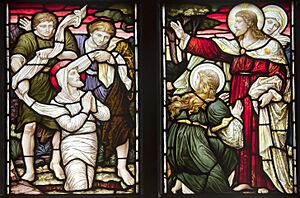Carl Almquist facts for kids

Carl Almquist (1848 – 1924) was a talented artist who created beautiful stained-glass windows. He was born in Sweden but spent his whole career in Britain. Carl learned from a famous artist named Henry Holiday. He became one of the main designers for a well-known company called Shrigley and Hunt in Lancaster. He helped create their special "Pre-Raphaelite" or "Aesthetic" style, which was very popular. For a long time, art experts didn't pay much attention to his work. But recently, people have realized he was a true genius and one of the best stained-glass artists of his time.
Contents
Carl Almquist's Artistic Journey
Early Life and Training
Carl Almquist was born in 1848 in Almby, near Örebro, Sweden. He dreamed of studying how to make stained glass. Since he couldn't learn this in Sweden, he traveled to England. He was 22 years old and had help from a teacher named Adolf Kjellström.
In England, Carl became a student of Henry Holiday. Holiday was a leading artist in the Pre-Raphaelite art movement. Carl quickly became an employee for Holiday. He also worked with other studios like Burlison and Grylls and James Powell and Sons.
Joining Shrigley and Hunt
In December 1873, Carl started working for a new company. This was Shrigley and Hunt in Lancaster. He designed stained glass and other decorations for them. By 1876, he became a full-time employee and moved to Lancaster.
At Shrigley and Hunt, Carl worked closely with the founder, Arthur William Hunt. He also worked with another main designer, Edward Holmes Jewitt. They used special techniques Carl learned from Henry Holiday. This helped them create a unique "house style" for the company.
Developing a Unique Style
Their style used soft colors, which became richer over time. They also focused on delicate, detailed drawings. This look defined Shrigley and Hunt's work for many years. Carl soon found he preferred living in London. To keep him with the company, Hunt opened a London office for him in 1878.
Carl continued to learn and grow as an artist. From 1878 to 1884, he attended the West London School of Art. This led to him winning a special scholarship. He spent two months in Italy studying decorative art.
Evolving Artistic Influences
As years passed, Carl's artistic style changed. The early Pre-Raphaelite influence became less strong. Instead, he was inspired by artists like Botticelli and Dürer. He also looked at ideas from Scottish glass designers of his time.
Carl designed many windows across Britain. You can find his work in Scotland, Wales, and various parts of England. He never returned to live in Sweden. However, he designed several stained-glass windows for St Nicholas Church in Örebro. His old friend Adolf Kjellström was helping to restore this church. Carl also designed windows for the Olaus Petri Church in the same town.
Retirement and Legacy
In 1920, Carl's eyesight began to fail. He decided to retire to Hove, a seaside town in Sussex. He still sent designs to Shrigley and Hunt, and they paid him for them. However, these later designs were never used. Carl Almquist passed away in Hove in 1924.
Carl Almquist's Works



